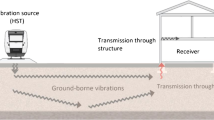Abstract
Evaluation of the vibration transmitted to a building due to nearby passing underground trains is an important design need nowadays. There are no easily available tools for this purpose, and in many cases, engineers must resort to local measurement and vibration experiments. As a simple alternative, in this paper the idea of using seismic design spectra for earthquake analysis is extended to dealing with train-induced vibrations. In this regard, maximum accelerations are calculated for single-degree-of-freedom systems with natural periods of 0–4 s subjected to passage of an underground train. The dynamic wheel loads are determined first and then applied to a 3D soil-tunnel system. The problem is analyzed for the three most common train types, three train velocities, three different tunnel depths, three soil types and three damping ratios of the structure. The analysis results in the design spectral acceleration for 243 cases of passing trains. By comparison to the comfort threshold, cases in which the serviceability is breached are highlighted. The spectra presented can be used as a very simple tool for analysis of the train-induced vibrations in modal analysis of structures.











Similar content being viewed by others
References
Alonso A (2010) Air suspension characterization. Increasing Air Suspension Effectiveness by means of a variable area orifice, Construcciones y Auxiliar de Ferrocarriles, S.A. and TECNUN (University of Navarra), vol 12
Bayraktar M, Guclu R, Metin M (2009) Modelling of air springs in a rail vehicle. In: 13th International research/expert conference ”trends in the development of machinery and associated technology” 16–21 October 2009, Hammamet, Tunisia, pp 829–832
Behnamfar, F, Nikbakht R (2013) Structural response spectra under passing underground trains. In: 3rd international conference on recent advances in railway engineering Apr 30, May 1, 2013, Iran University of Science and Technology, Tehran, I.R. Iran, pp 1–7
Bian XC, Chen YM, Hu T (2007) Numerical simulation of high-speed train induced ground vibrations using 2.5D finite element approach. Sci China Ser G Phys Mech Astron 51:632–650
Connolly DP, Kouroussis G, Giannopoulos A, Verlinden O, Woodward PK, Forde MC (2014) Assessment of railway vibrations using an efficient scoping model. Soil Dyn Earthq Eng 58:37–47
Dassault systemes, Abaqus, Dassault systemes Simulia Corp, RI, USA.
Eitzenberger A (2008) Train-induced vibrations in tunnels—a review. In: Luleå (Ed.), Luleå University of Technology, Sweden
Gupta S, Liu WF, Degrande G, Lombaert G, Liu WN (2008) Prediction of vibrations induced by underground railway traffic in Beijing. J Sound Vib 310:608–630
Huang H, Chrismer S (2013) A dynamic train-track interaction model to study track performance under “critical speed”. In: 92nd annual meeting of the transportation research board January, 2013, Washington, DC, USA, p 18
Hunt HEM, Hussein MFM (2007) Ground-borne vibration transmission from road and rail systems: prediction and control. In: Crocker MJ (ed) Handbook of noise and vibration control. John Wiley & Sons Inc, pp 1458–1469
Hussein M, Hunt H (2004) Dynamic effect of slab discontinuity on underground moving trains. In: 11th international congress on sound and vibration 5–8 July, ST. Petersburg, Russia, pp 3047–3054
Kogut J, Lombaert G, François S, Degrande G, Haegeman W, Karl L (2003) High speed train induced vibrations: in situ measurments and numerical modelling. In: 10th congress on sound and vibration 7–10 July—2003, Stockholm, Sweden
Krylov VV (2014) Focusing of ground vibrations generated by high-speed trains. In: Sas P (ed) International conference on noise and vibration engineering 15–17 September 2014. KU Leuven, Leuven, Belgium, pp 2007–2016
Li K (2011) Study on the dynamic response of track structure under moving loads with variable speeds. In: Roeck GD (ed) 8th International conference on structural dynamics, EURODYN 4-6 July 2011, Leuven, Belgium, pp 846–851
Lombaert G, Francois S, Verbraken H, Degrande G, Thompson DJ (2014) Numerical, experimental and hybrid methods for the prediction of railway-induced ground vibration. In: A.C. et. al (ed) 9th international conference on structural dynamics, EURODYN 30 June–2 July 2014, A. Cunha, Porto, Portugal, pp 91–99
Nicolosi V, D'Apuzzo M, Bogazzi E (2012) A unified approach for the prediction of vibration induced by underground metro. Procedia Soc Behav Sci 53:62–71
Pogorelov D, Universal Mechanism, in, Laboratory of Computational Mechanics, Bryansk State Technical University, Bryansk, Russia
Presthus M (2002) Derivation of air spring model parameters for train simulation. In: Department of applied physics and mechanical engineering division of fluid mechanics, LULEA University of Technology, p 74
Pretlove JH, Rainer AJ (1995) Human response to vibrations. In: Bachman HEA (ed) Vibration Problems in Structures. Birkhäuser, Basel, p 237
Sayyaadi H, Shokouhi N (2009) A new model in rail–vehicles dynamics considering nonlinear suspension components behavior. Int J Mech Sci 51:222–232
Seismosoft Group, SeismoSignal, Earthquake Engineering Software Solutions, Piazza Castello 19, 27100 Pavia, Italy
Takemiya H (2003) Simulation of track–ground vibrations due to a high-speed train: the case of X-2000 at Ledsgard. J Sound Vib 261:503–526
Verbraken H, Lombaert G, Degrande G (2012) Experimental and numerical prediction of railway induced vibration. J Zhejiang Univ Sci A (appl Phys Eng) 13:802–813
Woodward PK (2013) The development and mitigation of ground mach cones for high speed railways. In: Dimitrovová Z (ed) 11th International conference on vibration problems 9–12 September 2013, Lisbon, Portugal, pp 1–10.
Wu Q, Cole C, Spiryagin M, Quan Sun Y (2014) A review of dynamics modelling of friction wedge suspensions, Veh Syst Dyn 27
Yazdani AA (2017) Spectral analysis of structures under vibration due to underground passing trains. Faculty of Engineering, Islamic Azad University, Isfahan (Khorasgan) Branch, p 142
Author information
Authors and Affiliations
Corresponding author
Rights and permissions
Springer Nature or its licensor (e.g. a society or other partner) holds exclusive rights to this article under a publishing agreement with the author(s) or other rightsholder(s); author self-archiving of the accepted manuscript version of this article is solely governed by the terms of such publishing agreement and applicable law.
About this article
Cite this article
Yazdani, A.A., Behnamfar, F. Serviceability Design Spectral Acceleration for Structures Subjected to Passing Underground Trains. Iran J Sci Technol Trans Civ Eng 47, 3055–3069 (2023). https://doi.org/10.1007/s40996-023-01117-7
Received:
Accepted:
Published:
Issue Date:
DOI: https://doi.org/10.1007/s40996-023-01117-7




